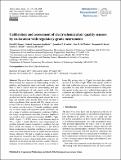Calibration and assessment of electrochemical air quality sensors by co-location with regulatory-grade instruments
Author(s)
Wallace, Lisa M. M.; Hagan, David Henry; Isaacman, Gabriel; Franklin, Jonathan Pfeil; Kocar, Benjamin David; Heald, Colette L.; Kroll, Jesse; ... Show more Show less
Downloadamt-11-315-2018.pdf (5.438Mb)
PUBLISHER_CC
Publisher with Creative Commons License
Creative Commons Attribution
Terms of use
Metadata
Show full item recordAbstract
The use of low-cost air quality sensors for air pollution research has outpaced our understanding of their capabilities and limitations under real-world conditions, and there is thus a critical need for understanding and optimizing the performance of such sensors in the field. Here we describe the deployment, calibration, and evaluation of electrochemical sensors on the island of Hawai'i, which is an ideal test bed for characterizing such sensors due to its large and variable sulfur dioxide (SO 2 ) levels and lack of other co-pollutants. Nine custom-built SO 2 sensors were co-located with two Hawaii Department of Health Air Quality stations over the course of 5 months, enabling comparison of sensor output with regulatory-grade instruments under a range of realistic environmental conditions. Calibration using a nonparametric algorithm (k nearest neighbors) was found to have excellent performance (RMSE < 7ppb, MAE < 4ppb, r2 > 0.997) across a wide dynamic range in SO 2 ( < 1ppb, > 2ppm). However, since nonparametric algorithms generally cannot extrapolate to conditions beyond those outside the training set, we introduce a new hybrid linear-nonparametric algorithm, enabling accurate measurements even when pollutant levels are higher than encountered during calibration. We find no significant change in instrument sensitivity toward SO 2 after 18 weeks and demonstrate that calibration accuracy remains high when a sensor is calibrated at one location and then moved to another. The performance of electrochemical SO 2 sensors is also strong at lower SO 2 mixing ratios ( < 25ppb), for which they exhibit an error of less than 2.5ppb. While some specific results of this study (calibration accuracy, performance of the various algorithms, etc.) may differ for measurements of other pollutant species in other areas (e.g., polluted urban regions), the calibration and validation approaches described here should be widely applicable to a range of pollutants, sensors, and environments.
Date issued
2018-01Department
Massachusetts Institute of Technology. Department of Chemical Engineering; Massachusetts Institute of Technology. Department of Civil and Environmental Engineering; Massachusetts Institute of Technology. Department of Earth, Atmospheric, and Planetary SciencesJournal
Atmospheric Measurement Techniques
Publisher
Copernicus GmbH
Citation
Hagan, David H. et al.“Calibration and Assessment of Electrochemical Air Quality Sensors by Co-Location with Regulatory-Grade Instruments.” Atmospheric Measurement Techniques 11, 1 (January 2018): 315–328 © 2018 Author(s)
Version: Final published version
ISSN
1867-8548